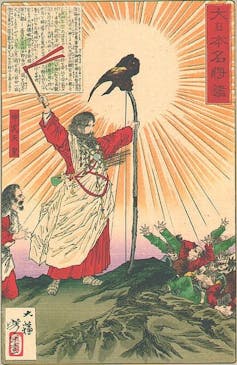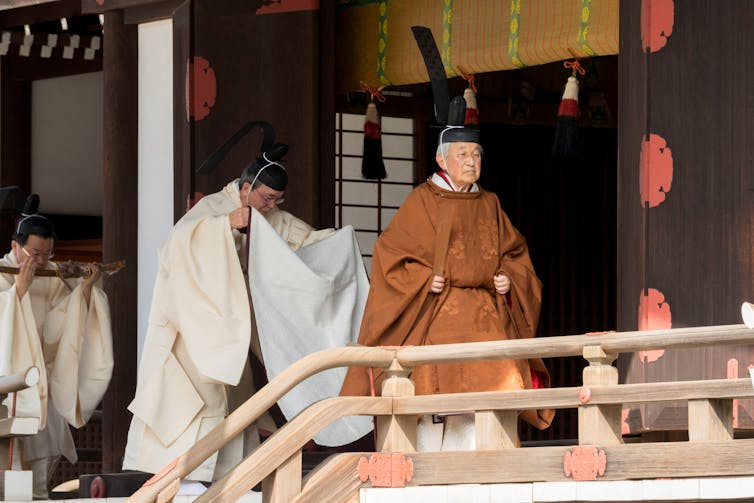Japan’s next emperor is a modern, multilingual environmentalist
- Written by Constantine Nomikos Vaporis, Professor of History, University of Maryland, Baltimore County
For the first time in 217 years, a Japanese emperor will cede his place on the imperial throne[1].
On April 30, Japan’s ailing 85-year-old Emperor Akihito will abdicate and be replaced the following day by his 59-year-old son, Crown Prince Naruhito.
Naruhito and his wife, Crown Princess Masako, are a modern couple. Both have studied overseas – he at Oxford University, she in Russia, England and the United States. Born after World War II, Naruhito will be the first Japanese emperor not shaped by the upheaval that war brought to his country.
Many Japanese are hopeful that these younger royals can update Japan’s ancient “Chrysanthemum Throne[2].” But changing a 14-century-old monarchy to reflect the times will not be easy.
A democracy with an emperor
Japan has the oldest continuous monarchy in the world.
The current emperor, Akihito, is the 125th in a royal line of succession officially founded in the 7th century[3]. According to Japanese legend, however, the Chrysanthemum Throne dates back 2,600 years – to the country’s founding in 660 B.C. by Emperor Jimmu, a descendant of the Shinto sun goddess, Amaterasu.
 Emperor Jimmu, of Shinto legend.
Emperor Jimmu, of Shinto legend.
Despite their sacred status, Japanese emperors have traditionally reigned but not run the country. For most of its long history, military governments or oligarchs governed Japan in a day-to-day sense.
In 1947, two years after its surrender to Allied forces[4], Japan became a democracy, with several political parties, parliament and a prime minister[5]. The monarchy also changed[6] profoundly after World War II.
Emperor Hirohito – father of Japan’s current emperor, Akihito – renounced “the false conception that the emperor is divine[7]” in 1946 under pressure from Allied forces. The largely American-written 1947 constitution that followed officially reduced the emperor to a figurehead[8].
Still, the monarchy continued. And Hirohito remained on the throne until his death at age 88 in 1989[9].
The people’s emperor
Hirohito’s son, Emperor Akihito has, by most accounts, been a hugely popular monarch[10] – one who put his personal stamp on this institution.
As a young crown prince in U.S.-occupied Japan, Akihito studied the English language and western culture[11], and his American tutor sought to encourage independence in her young student. Akihito later broke with the Japanese royal tradition of arranged marriages by wedding a commoner, Michiko Shoda, whom he met playing tennis[12].
 Japan’s popular 85-year-old emperor, Akihito will abdicate on April 30, 2019.
Imperial Household Agency of Japan/Handout via Reuters[13]
Japan’s popular 85-year-old emperor, Akihito will abdicate on April 30, 2019.
Imperial Household Agency of Japan/Handout via Reuters[13]
Akihito has brought the monarchy closer to the people of Japan in other ways over the last 30 years, too.
He spent more time outside the confines of his palace, interacting with ordinary Japanese, than his aloof father[14]. He and the empress also made official visits to some 35 countries.
After the 2011 earthquake and tsunami that triggered Japan’s Fukushima nuclear crisis, Emperor Akihito made a historic television appearance[15], urging his people not to give up hope, and visited refugees at an evacuation center[16].
In a 2016 speech[17], Akihito indirectly signaled his intention to abdicate, saying that his advanced age and declining health made it difficult for him to carry out his duties.
Resigning on April 30 will be the last modernizing act of Akhito’s 30-year reign.
The crown prince says that as emperor he hopes to emulate his father’s personal touch – to “share the joys and sorrows of the people[18].”
Controversy over all-male succession
The abdication of a living emperor created a legal problem for Japan, where imperial law defines imperial succession only upon death[19].
The last Japanese monarch to step down, Emperor Kokaku, did so in 1817 for unknown reasons, and before Japan became a democracy. There is simply no modern precedent for Akihito’s decision.
Amending Japanese imperial law to accommodate abdication would have opened it up to other changes. Specifically, many Japanese legislators and a majority of Japanese people[20] wanted to allow women to inherit the throne[21].
That would be a big symbolic boost for women in a country where female executives occupy less than 1% of management positions[22].
Conservative forces in legislature, however, blocked calls to change Japan’s male succession tradition. Rather than amend the imperial law, they simply passed a special law allowing Akihito to step down[23].
That means Aiko, the daughter of Japan’s soon-to-be emperor and empress cannot succeed her father[24]. Next in line, instead, is Naruhito’s younger brother, 53-year-old Prince Fumihito. Fumihito will be followed by his son, Hisahito.
Emperor Naruhito, the environmentalist
I had occasion to meet Prince Naruhito, Japan’s next emperor in 1990, at an academic conference in Japan.
As a scholar of Japanese history[25], I spoke about the travels of a prominent samurai in early modern Japan[26]. Naruhito – long a global advocate for clean water[27] – presented his research[28], conducted at Oxford University, on medieval English water transport.
Naruhito has continued to develop his environmental pursuits[29] since. In 2007, he was appointed honorary president of the United Nations Secretary General’s Advisory Board on Water and Sanitation.
Naruhito’s global civic engagement shows how the crown prince has sought to steer his own course in life.
His wife, Masako[30], will also be unlike any empress in Japanese history.
The daughter of a diplomat and fluent in several languages, Masako graduated from Harvard in 1985 with a degree in economics, and later studied law at the University of Tokyo. In 1987, she was one of only three women – in a pool of 800 applicants – to pass the entrance exam for the Japanese Ministry of Foreign Affairs[31].
Nahurito proposed three times before Masako agreed to marry him, in 1993. That decision forced her, reluctantly, to give up her diplomatic career.
The lifestyle change appears to have been difficult for Masako.
As crown princess, she came under intense pressure to produce a male heir. Royal household officials also limited her overseas travel and closely monitored her movements[32].
In 2001, eight years after their marriage, Masako gave birth – but to a girl, Aiko[33]. Shortly afterward, she vanished from public life. According to her doctors, Masako suffered an “adjustment disorder” – what outside observers might identify as depression.
Prince Naruhito has broken with a royal tradition of discretion in 2004 and spoken publicly about his wife’s struggle to adapt to her constrained new existence.
“There were moves to negate Masako’s career and her personality, which was influenced by that career,” he told reporters in 2004[34].
Masako began reappearing in public again only in 2014[35]. She has expressed both anxiety and optimism[36] about becoming empress, given the stresses and ceremonial duties of that office.
Naruhito, for his part, says he will work to change how Japan’s royal family operates, updating the imperial household to reflect changing times.
His goal for his reign, he says, is to bring “a fresh breeze[37]” to the Chrysanthemum Throne.
References
- ^ imperial throne (www.nytimes.com)
- ^ Chrysanthemum Throne (www.independent.co.uk)
- ^ founded in the 7th century (factsanddetails.com)
- ^ its surrender to Allied forces (www.history.com)
- ^ several political parties, parliament and a prime minister (japan.kantei.go.jp)
- ^ changed (www.nytimes.com)
- ^ the false conception that the emperor is divine (www.chukai.ne.jp)
- ^ figurehead (www.ndl.go.jp)
- ^ death at age 88 in 1989 (www.nytimes.com)
- ^ hugely popular monarch (www.scmp.com)
- ^ studied the English language and western culture (www.goodreads.com)
- ^ playing tennis (www.kunaicho.go.jp)
- ^ Imperial Household Agency of Japan/Handout via Reuters (pictures.reuters.com)
- ^ aloof father (www.nytimes.com)
- ^ historic television appearance (www.huffingtonpost.com)
- ^ visited refugees at an evacuation center (www.bbc.com)
- ^ 2016 speech (www3.nhk.or.jp)
- ^ share the joys and sorrows of the people (www.japantimes.co.jp)
- ^ defines imperial succession only upon death (www.kunaicho.go.jp)
- ^ majority of Japanese people (www.japantimes.co.jp)
- ^ allow women to inherit the throne (www.theguardian.com)
- ^ less than 1% of management positions (www.oecd.org)
- ^ allowing Akihito to step down (www.telegraph.co.uk)
- ^ cannot succeed her father (www.asahi.com)
- ^ scholar of Japanese history (history.umbc.edu)
- ^ prominent samurai in early modern Japan (uhpress.hawaii.edu)
- ^ global advocate for clean water (webtv.un.org)
- ^ his research (openlibrary.org)
- ^ continued to develop his environmental pursuits (www.reuters.com)
- ^ Masako (www.kunaicho.go.jp)
- ^ to pass the entrance exam for the Japanese Ministry of Foreign Affairs (royalcentral.co.uk)
- ^ monitored her movements (www.theguardian.com)
- ^ a girl, Aiko (www.chicagotribune.com)
- ^ told reporters in 2004 (www.theguardian.com)
- ^ reappearing in public again only in 2014 (www.bbc.com)
- ^ anxiety and optimism (www.theguardian.com)
- ^ a fresh breeze (www.bbc.com)
Authors: Constantine Nomikos Vaporis, Professor of History, University of Maryland, Baltimore County
Read more http://theconversation.com/japans-next-emperor-is-a-modern-multilingual-environmentalist-109922

